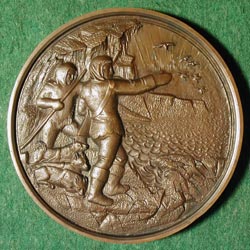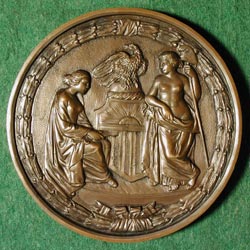|
ALASKA ARCTIC EXPLORATION
by Tiffany and Company: USA, 1857, Bronze, 78 mm
Obv: Two men, representing Morton and Hans, with dogs, on coast of Alaska exploring the
Open Polar Sea.
Rev: Eagle above shield between seated History and
standing Liberty. The design is modified from the Arms of the State of
New York.
Extremely rare.
Ref: Gould and Bresset, 1960, #102
This medal has the same obverse and reverse as that made by the Tiffany
Company in 1857, which was made in gold and awarded by the State of New York to Dr.
Elisha Kent Kane for his Arctic expeditions and for searching for the lost Franklin
expedition. The original gold medal is inscribed on its edge "Presented to Dr. E. K.
Kane, U.S.N., for his gallant services in search of Sir John Franklin, by the State of New
York, 1857." A smaller medal with a slightly different design was awarded at the same
time to Lieut. H.S. Hartstein/Hartstene, USN, also for his Arctic discoveries and for his
search for Kane whom he eventually recovered.
The Franklin Expedition (more properly the British North-West Passage Expedition of
1845-48) was led by Sir John Franklin, Royal Navy. They were seeking a sea route linking
the Atlantic with the Pacific Oceans via the Arctic Seas, a passage that had been sought
for centuries, with the British having a major interest in this endeavor. One such attempt
was begun in the spring of 1845, when Her Majesty's Discovery Ships Erebus and Terror
carried some 129 men to the Arctic - never to return. Search expeditions failed to find
the ships, but did discover various artifacts and bones from the lost Expedition.
During the Kane expedition their vessel became ice-locked so he sent out a dog sledge
party under William Morton, in company with an Eskimo named Hans (Hans Hendrik) to explore
the area further. These two, who are depicted on the obverse of the medal, were the only
men who ultimately saw open water.
In addition to the gold medal presented to Kane, an example of this medal in bronze and an
example of the Hartstein medal in silver are extant (Dick Powell Collection, Kodiak,
Alaska). (Taken, in part, from Frank Leslie's Illustrated Newspaper, Jan. 9, 1858.)
(Many thanks to Glenn M. Stein, FRGS, who generously provided this information.)
The example of the medal shown above is in bronze and appears to have been made in two
parts, joined together at the edge.
LINK to Kane's Open
Polar Sea (from www.ekkane.org)
LINK to Alaska
Exploration (from www.pbs.org)
HOME PAGE |

